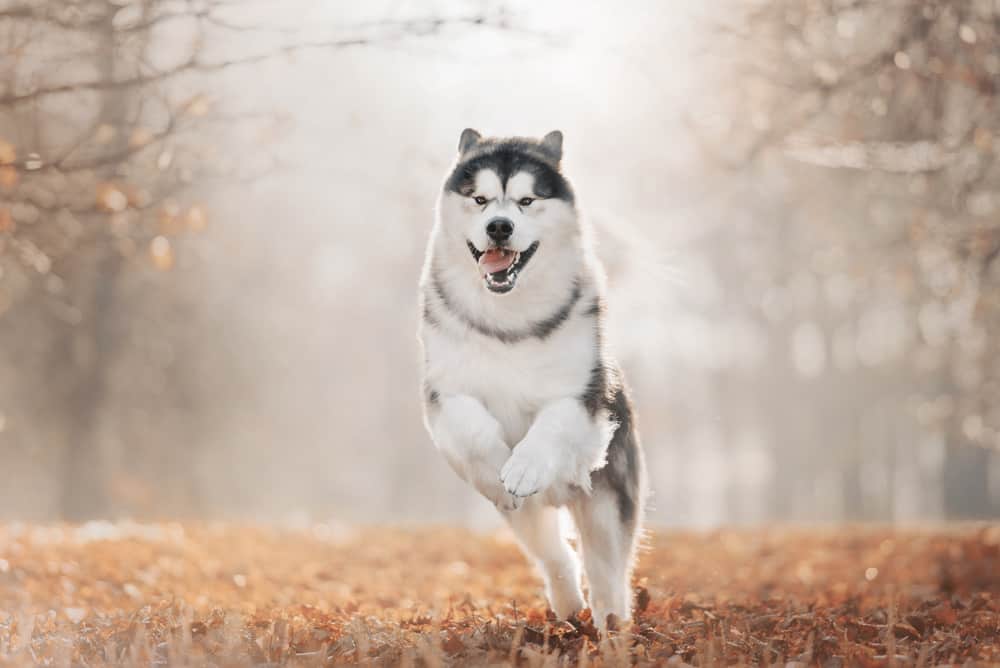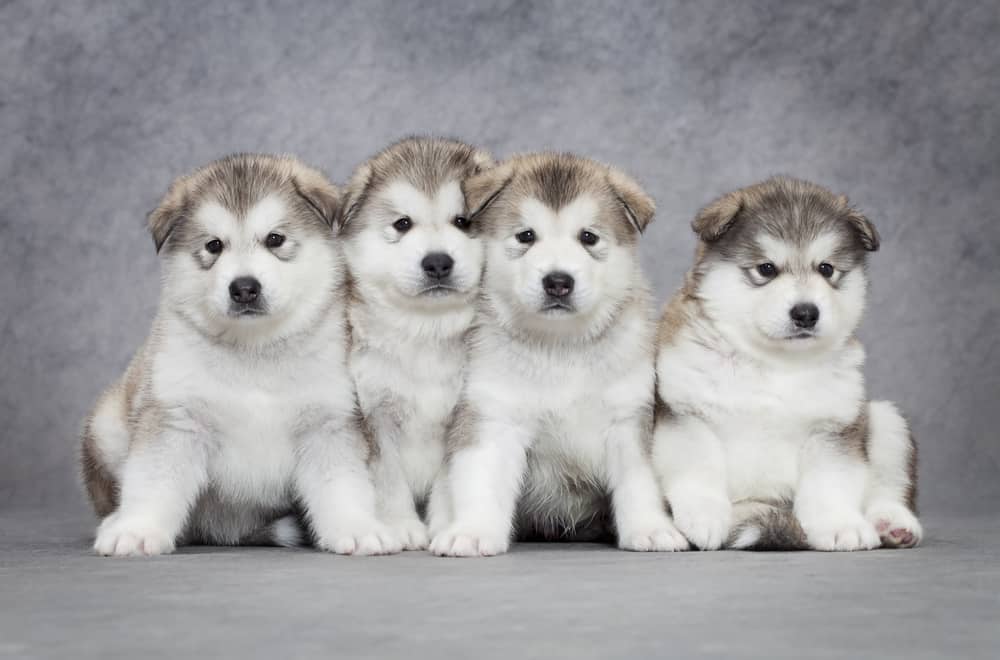Complete Guide To The Alaskan Malamute: Care, Grooming, Feeding and More
Alaskan Malamutes are the workhorses of the canine world. Agility trials, weight-pulling competitions, obstacle courses and more — they can do it all. But these muscular, energetic athletes also have a faithful and affectionate side and can be devoted companions for dedicated owners willing to train them.
Alaskan Malamutes have been a consistently popular dog in my veterinary practice. I’ve been around the breed for over 30 years and the following information is based on that experience.

Table of Contents
How Big Do Alaskan Malamute Get?
Alaskan Malamutes average 75 – 85 pounds and stand 23–25 inches high.
Brawny but dignified, they carry themselves with pride. Often confused with the smaller Siberian Husky, the larger Malamute has a wider head, deeper chest and broader shoulders.
What Different Colors Do Alaskan Malamutes Come In?
Their double coats are thick but not long. Colors include:
• White
• Agouti and white
• Black and white
• Blue and white
• Gray and white
• Red and white
• Seal and white
• Silver and white
• Sable and white
Colored points and a splash of white on the forehead are common.
Unlike Siberian Huskies, a Mal’s almond-shaped eyes are brown — blue eyes are a disqualification. Their bushy tails are curved over their backs when they’re relaxed. Ears are triangular, erect and responsive, set high on the head.
What Kind Of Personality Do Alaskan Malamutes Have?
Alaskan Malamutes are friendly and approachable but not needy. Easy-going, their stable temperament and laissez-faire attitude make them good pets but second-rate guard dogs.
Bred for working, Mals are tireless — the only thing they’ll ever demand is exercise. If you give them less than an hour a day, their energy can become destructive.
Relationships with Malamutes are a two-way street. They have minds of their own and need firm guidance. Dogs that aren’t clear about who’s in charge will take the reins — never let them doubt it’s you.
Still, their intelligence is worthy of respect, and a fair owner will work with their personality, not against it. The reward will be a lasting friendship.
What Kind Of Grooming Do Alaskan Malamutes Need?
A Malamute’s heavy double coat is well-adapted for harsh conditions. A short wooly layer insulates the skin from cold temperatures, and a coarse top coat deflects snow, wind and rain. But since most Mals dogs don’t live in the Arctic weather they were bred for, their coats require regular care — warm climates give their bodies mixed signals.
Malamutes lose hair consistently, and their undercoats shed seasonally in the spring and fall. Every day brushing with a wire-pin brush or steel comb keeps their skin in top condition. Hair on their tail, neck and hindquarters is vulnerable to matting and needs special attention.
Most Mals benefit from a bath every few months. Use a pH-balanced shampoo to avoid over drying their coat. Light conditioner helps prevent tangles, but going overboard can make their hair sticky.
The Malamute’s ear canals get plenty of air, so they aren’t particularly prone to infections and need only occasional cleaning. Their feet, however, are compact with toes packed tightly together. Overgrown nails can cause significant pain, so examine them regularly and keep them trim.
How Much Exercise Do Alaskan Malamutes Need?
This breed requires a great deal of exercise. Don’t expect yours to want to lay around and sleep most of the time until they are pretty old.
Daily long walks are essential for a properly happy and emotionally balanced Malamute. They can get nervous and insecure if they don’t burn off that energy.
Because of their heritage, some of the dogs may naturally be great hikers and you can always have them wear a backpack loaded with water or other supplies to help them work their bodies more. Sled pulling is another way to give them a challenge in pulling more than their own weight.
This is a dog that could benefit from the use of a weighted vest. Just be mindful of the total weight they are carrying and observe them after wearing one. If they seem overly exhausted after a walk with one, lighten up the weight in the vest. Always make sure when using a weighted vest that your dog is healthy and has no orthopedic problems that could be worsened with the added weight load.

What Kind of Dog Food Is Best For Alaskan Malamutes?
For Alaskan Malamute puppies, you will need to make sure you don’t feed them too much too fast. It’s easy because they are usually chow hounds, but you want to control their growth. Growing too fast can cause some early bone and joint problems that are easily avoided.
Best Puppy Food For Alaskan Malamutes:
Best Adult Food For Alaskan Malamutes:
- Purina Pro Plan Large Breed
- Eukanuba Adult Dry Dog Food
- Nutro Natural Choice Large Breed Adult
- Merrick Classic Healthy Grains Dry Dog Food
Please don’t listen to the folks at the pet store trying to convince you to buy a grain-free diet for your dog. There’s zero science behind that and vets are actually seeing diseases now related to feeding grain-free foods.
It’s very important they remain at their optimal weight throughout their life. Because of their huge amount of coat, it can be difficult for an owner to understand when their Malamute is overweight. Have your vet go over with you exactly where to feel to know when your dog is too big.
How Long Do Alaskan Malamutes Generally Live?
10-14 years based on info from the AKC
What Health Conditions Do Alaskan Malamutes Commonly Have?
The most common health problems I see in my Malamute patients are:
- Obesity
- Hip Arthritis/Dysplasia
- Elbow Arthritis/Dysplasia
Where Can I Find An Alaskan Malamute?
Breeder List From the Alaskan Malamute Club of America
Looking for a Rescue? Check out the Resource Page For the Alaskan Malamute Assistance League

Where To Learn More About Alaskan Malamutes
Alaskan Malamute Club of America
Search for a local/regional breed club for meetings, etc.
Interesting Facts About Alaskan Malamutes
Alaskan Malamutes are affable, hard-working dogs. But here are a few facts that might surprise you about this magnificent breed.
• Malamutes are Slackers as Sledders
Alaskan Malamutes were built for strength. The largest of Nordic breeds, they can haul heavy loads over long distances, but they’re not quick about it. Compared to the smaller, faster Siberian Husky, their size and weight make them too slow to be efficient sled dogs.
• They Were Almost Lost to the Gold Rush
Record numbers of strong dogs were needed to help gold miners traverse tough terrain during the Gold Rush. In three short years — 1896 – 1899 — many were lost or their genetic purity compromised through crossbreeding with other work dogs. It’s said their numbers reached less than forty before efforts were made to preserve the breed.
• Malamutes Are Genetically Diverse
Friends to the Inuit, Malamutes were bred from Alaska to Greenland, resulting in different regional strains —only the original Kotzebue variety was initially recognized by the AKC. But their diminishing numbers after World War II threatened to wipe out the breed, so the AKC opened the studbook to M’Loot and Hinman strains in the 1950s. Today, the Malamute gene pool contains all three varieties.
• There May Be Better Breeds for Young Children
A well-trained Malamute can be an excellent companion for older children. But they’re roughousers that don’t know their strength and will bowl over young children without meaning any harm. Training helps, but be cautious.
• Malamutes Love to Dig
Alaskan Malamutes dig — training can lessen the behavior, but it’s tough to tame. The safest creative outlet is toys that require digging behavior to use. Alternatives include avoiding areas where digging is problematic or making the most of it — one clever Mal owner had her patio dug for free.
• They Were Honored by the Postal Service
The Alaskan Malamute was among the dogs chosen by the US Postal Service for their 1984 AKC Centennial stamps. Sharing the honor were the Beagles, Black and Tan Coonhound, American Foxhound, Boston Terrier, Chesapeake Bay Retriever, Collie and Cocker Spaniel. The stamps were designed by artist Roy Andersen and cost twenty cents.
• Warm Climates Aren’t Ideal for Malamutes
Malamutes can thrive in almost any environment, but they can’t fight Mother Nature. Their fur is Arctic-insulated and they tend to overheat in hot weather, especially with activity. If you live where it’s summer year-round, consider a different breed.
• Finally, They’re Alaska’s State Dog
Alaskan Malamutes weren’t their namesake state’s dog until 2010. Over four hundred students, parents, and teachers from the Polaris K–12 school in Anchorage spearheaded an effort to give the breed their due. After three years of hard work, then-Governor Sean Parnell signed the bill making it law.
